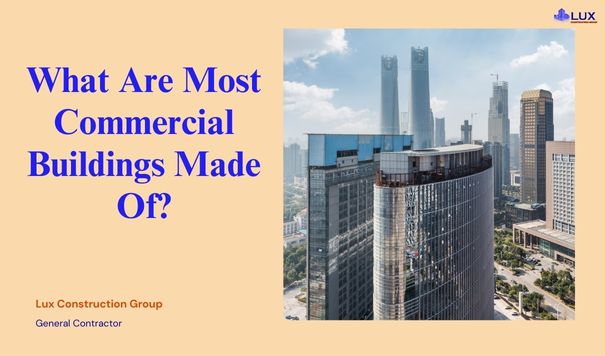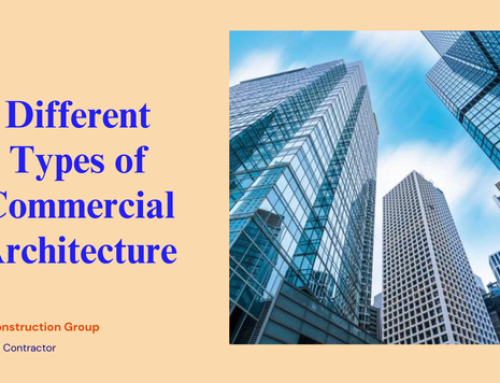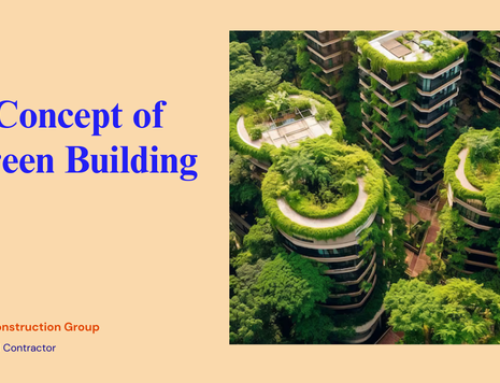Commercial buildings are the backbone of any thriving city or town. From office complexes and shopping malls to hotels and restaurants, these structures play a vital role in supporting various industries and driving economic growth.
However, have you ever wondered what building materials go into constructing these impressive edifices?
Choosing the right construction materials is crucial in the construction industry. It not only determines the structural integrity and durability of the buildings but also impacts factors such as cost-efficiency, aesthetic appeal, and sustainability. Architects and builders meticulously evaluate different options to create building designs that are both functional and visually appealing. They consider the specific requirements of each commercial construction project while doing so.
In this blog, we’ll find out about the most commonly used building materials for commercial construction.
Contents
What Type of Building Material Is Best for My New Commercial Facility?
Choosing the right building materials for your new commercial facility is a critical decision. But, with a wide range of options available, the selection process can be daunting.
In this section, we’ll guide you through the key factors to consider when evaluating different building materials for your commercial project. So, let’s get started!
Concrete
Concrete is another prominent building material that plays a significant role in commercial constructions.
Known for its durability and cost-effectiveness, concrete has become a staple in the construction industry, particularly for commercial buildings.
Pros:
- Durability: Concrete is exceptionally durable and can withstand harsh environmental conditions, making it ideal for long-lasting commercial buildings.
- Fire Resistance: Like steel, concrete is non-combustible and offers superior fire resistance, ensuring safety in commercial establishments.
- Versatility: Reinforced concrete and precast panels allow for creative building designs, enabling architects to incorporate unique architectural elements.
- Cost-Effectiveness: Concrete is generally more affordable than other building materials, making it an economical choice for commercial concrete use.
- Low Maintenance: Concrete buildings require minimal maintenance compared to other structures, reducing long-term costs for owners.
- However, there are also some potential drawbacks to consider:
Cons
- Slower Construction: Concrete construction can be more time-consuming compared to other methods, potentially delaying project timelines.
- Environmental Impact: The production of concrete contributes to greenhouse gas emissions, raising sustainability concerns.
- Aesthetic Limitations: While concrete can be molded into various shapes, some may perceive it as less visually appealing than other building materials.
Examples of Concrete Applications in Commercial Buildings:
- Exterior Cladding
- Polished Concrete Floors
- Parking Structures
- Basements and Underground Structures
Steel
Steel has become a cornerstone material in commercial construction, particularly for high-rise buildings.
Renowned for its exceptional structural steel properties, steel offers a unique blend of advantages that contribute to the strength, efficiency, and aesthetics of modern commercial spaces.
Pros
- Strength and Durability: Steel boasts an impressive load-bearing capacity, making it ideal for supporting immense weight in high-rise buildings. This exceptional strength translates to long-lasting structures with superior structural integrity.
- Speed and Efficiency: Compared to traditional materials like concrete, steel framing allows for faster construction due to prefabrication capabilities. This translates to quicker project completion times and potentially lower labor costs.
- Design Flexibility: Steel is incredibly versatile and can be molded into various shapes and sizes. This flexibility empowers architects to translate their creative visions into reality, facilitating innovative and visually striking building designs.
- Fire Resistance: While steel is inherently not fireproof, it can be treated with fire-resistant coatings to significantly improve its fire resistance. This enhances overall building safety in case of a fire emergency.
Cons
- Cost: Steel can be a more expensive material upfront compared to some alternatives like concrete. However, the benefits of faster construction times and reduced labor costs can sometimes offset the initial investment.
- Corrosion: Steel is susceptible to corrosion if not properly protected. Utilizing corrosion-resistant coatings or opting for weathering steel varieties can mitigate this risk.
- Thermal Performance: Steel conducts heat efficiently, which can be a disadvantage in extreme climates. Proper insulation strategies are crucial to ensure optimal temperature control within the building.
Examples of Steel Applications in Commercial Buildings:
- Skyscrapers and high-rise office buildings
- Warehouses and industrial facilities
- Stadiums and sports arenas
- Shopping malls and convention centers
Brick and Masonry
Brick and masonry have long been trusted building materials for their timeless appeal and durability. These traditional materials continue to be widely used in commercial constructions, offering a blend of aesthetics and practicality.
The use of brick and masonry in commercial buildings offers several advantages:
Pros
- Durability: Brick and masonry are incredibly durable and can withstand harsh weather conditions, making them ideal for long-lasting commercial structures.
- Fire Resistance: These materials are non-combustible, providing excellent fire resistance and enhancing safety in commercial settings.
- Load-Bearing Capabilities: Brick and masonry walls can be load-bearing, allowing for versatile structural designs in commercial buildings.
- Thermal Mass: The high thermal mass of brick and masonry helps regulate indoor temperatures, contributing to energy efficiency.
- Low Maintenance: Once constructed, brick and masonry require minimal maintenance, reducing long-term costs for building owners.
Cons
- Higher Initial Costs: Brick construction and masonry can be more expensive than some other building materials, particularly for larger commercial projects.
- Labor-Intensive: Laying bricks and masonry is a labor-intensive process, potentially increasing construction time and costs.
- Limited Design Flexibility: While brick veneer can provide aesthetic versatility, the structural limitations of brick and masonry may restrict design flexibility compared to other materials.
Examples of Brick and Masonry Applications in Commercial Buildings:
- Exterior Walls and Facades
- Load-Bearing Walls
- Accent Walls and Design Features
- Fireplaces and Hearths
- Archways and Columns
- Exterior Paving and Walkways
- Historic Renovations and Restorations
Stone
Stone, both natural and engineered, is a popular building material choice for commercial constructions due to its beauty, durability, and versatility.
Pros
- Timeless Aesthetics: Natural stone, such as marble and granite, adds a luxurious and timeless appeal to commercial buildings, enhancing their visual impact.
- Durability: Stone is exceptionally durable and resistant to wear and tear, making it suitable for high-traffic areas in commercial settings.
- Low Maintenance: Natural stone buildings require minimal maintenance and can withstand harsh weather conditions without deteriorating.
- Versatility: Materials like engineered quartz and stone veneer allow for a wide range of design possibilities, enabling unique and modern applications in commercial constructions.
Cons
- High Costs: Stone in commercial construction, particularly natural varieties, can be significantly more expensive than other building materials.
- Weight and Structural Requirements: The weight of stone necessitates sturdy structural support, potentially increasing construction costs and complexity.
- Limited Availability: Certain types of natural stone may be scarce or have to be imported, leading to higher costs and potential supply chain issues.
Examples of stone Applications in Commercial Buildings:
- Exterior Cladding and Facades
- Interior Flooring and Wall Coverings
- Countertops and Surfaces
- Columns and Architectural Features
- Retail Displays and Fixtures
- Exterior Landscaping and Hardscaping Interior Fireplaces and Hearths
Wood
Wood, once a traditional building material, is making a resurgence in commercial construction as an eco-friendly and sustainable option. With advancements in technology and a growing emphasis on environmentally conscious practices, modern timber construction is gaining popularity for commercial buildings.
Pros
- Sustainability: Wood is a renewable resource, and when sourced from sustainable forestry practices, it has a lower carbon footprint compared to many other building materials.
- Aesthetic Appeal: Wooden commercial buildings exude warmth and natural beauty, adding a distinct ambiance to the interior and exterior designs.
- Structural Strength: Innovations like cross-laminated timber and engineered wood products have improved the strength and durability of wooden structures, making them suitable for larger commercial projects.
- Thermal and Acoustic Properties: Wood offers excellent insulation properties, contributing to energy efficiency and improved acoustics within the building.
Cons
- Fire Hazard: While treated wood can be fire-resistant, untreated wood poses a higher risk of fire compared to non-combustible materials like steel and concrete.
- Maintenance Requirements: Wooden buildings may require regular maintenance and protection against moisture and pests to ensure longevity.
- Cost Considerations: Depending on the project scope and location, sustainable wood construction can be more expensive than traditional building materials.
Examples of Wood Applications in Commercial Buildings:
- Cross-Laminated Timber (CLT)
- Glue-Laminated Beams (Glulam)
- Mass Timber Construction
- Exposed Wooden Ceilings and Beams
- Wooden Cladding and Siding
- Wooden Flooring
- Wooden Furniture and Fixtures
Straw Bales
Straw Bales are an unconventional yet eco-friendly building material gaining recognition in commercial construction. These tightly compacted bales of agricultural waste offer a sustainable alternative to traditional materials, appealing to businesses that prioritize environmental responsibility.
Pros
- Sustainability: Straw bales are made from a renewable resource, making them an environmentally friendly choice that aligns with green building practices.
- Thermal Insulation: The dense nature of straw bales provides excellent thermal insulation properties, contributing to energy efficiency in commercial spaces.
- Fire Resistance: When properly constructed with appropriate coatings and finishes, straw bale buildings can achieve fire resistance ratings comparable to conventional constructions.
- Cost-Effective: Straw bales are relatively inexpensive, making them a cost-effective building material option for commercial projects with budget constraints.
Cons
- Moisture Concerns: Straw bales are susceptible to moisture damage if not properly protected, which can lead to structural issues and mold growth.
- Limited Load-Bearing Capacity: Straw bale walls typically require additional structural support, limiting their use in larger or taller commercial buildings.
- Building Code Compliance: Some jurisdictions may have specific requirements or restrictions regarding the use of straw bales in commercial construction, potentially complicating the approval process.
- Specialized Expertise: Building with straw bales requires specific knowledge and techniques, which may necessitate hiring specialized contractors or additional training for construction crews.
Examples of Straw Bales Applications in Commercial Buildings:
- Wineries and Tasting Rooms
- Restaurants and Cafés.
- Retail Stores and Boutiques
- Educational Facilities
- Visitor Centers and Interpretive Facilities
- Residential and Mixed-Use Developments
Commercial Construction, Design, and Remodeling in Los Angeles, CA
As we’ve explored, the choice of building materials is a crucial consideration in commercial construction. From the towering steel skyscrapers that define modern cityscapes to the timeless charm of brick and stone structures, each material brings its unique strengths and aesthetic appeal to commercial buildings.
At LUX Construction Group, a construction company in Los Angeles, CA, we understand the importance of selecting the right building materials to meet the diverse needs of our clients in the commercial sector. Our team of experienced contractors, architects, and builders carefully evaluates the requirements of each project. We consider each factor and build design to create functional and visually striking commercial spaces.
We stay ahead of the curve, embracing innovative building materials and techniques while respecting the enduring charm of traditional materials like brick and masonry.
With our commitment to excellence and our deep understanding of commercial construction, LUX Construction Group is your trusted partner to create iconic commercial buildings that combine functionality, durability, and aesthetic appeal.
Contact us today to discuss your project and let us help you choose the perfect building materials to make your vision a reality.






